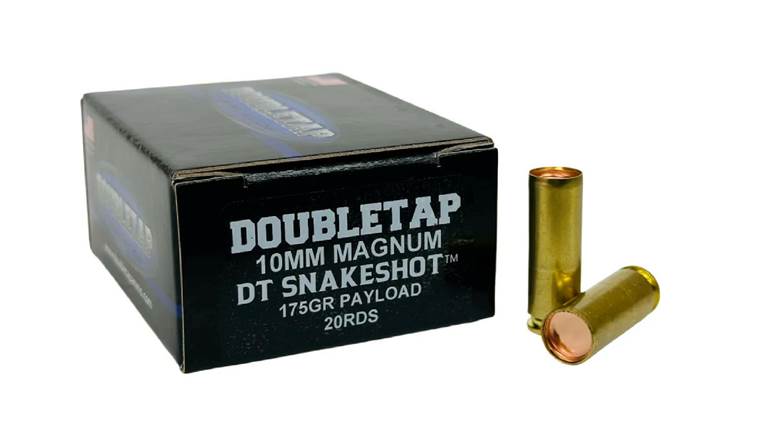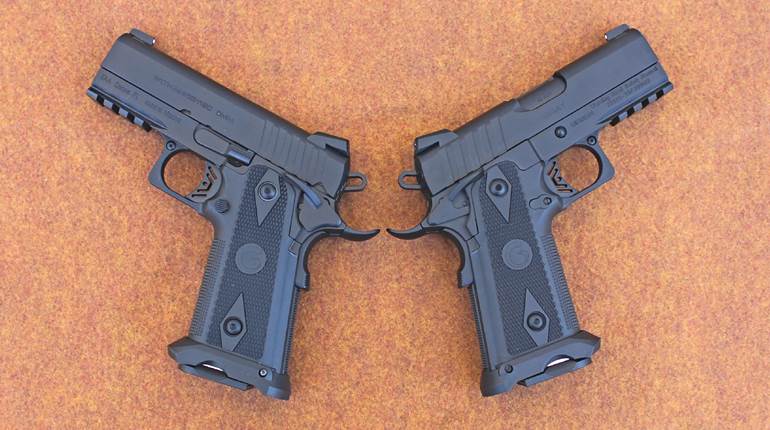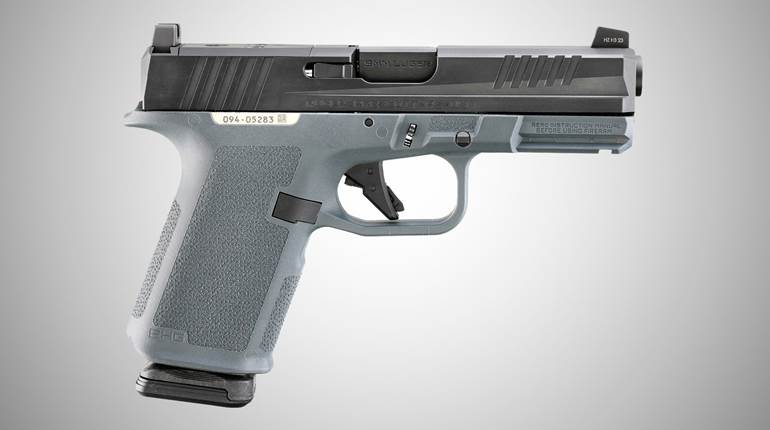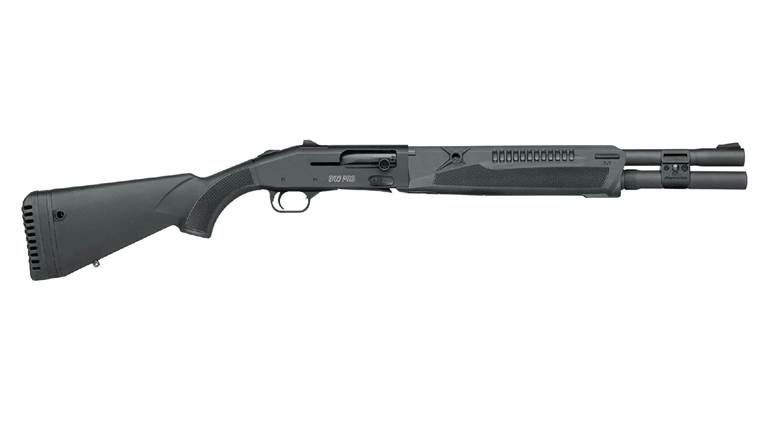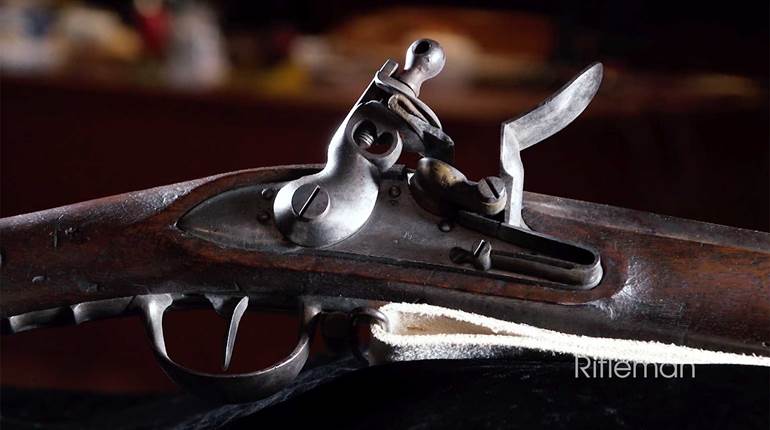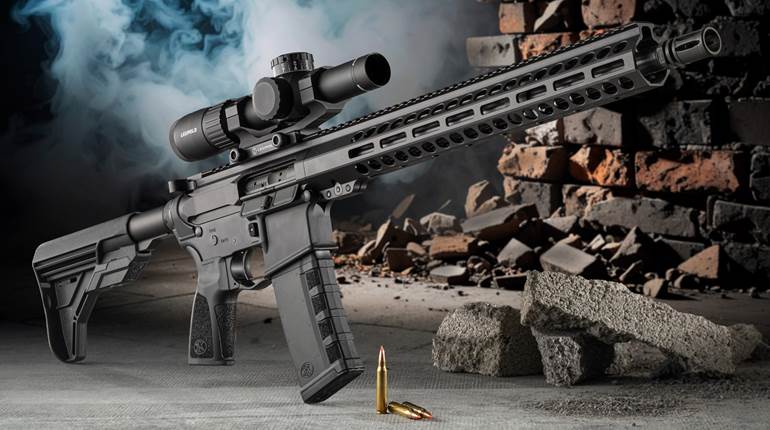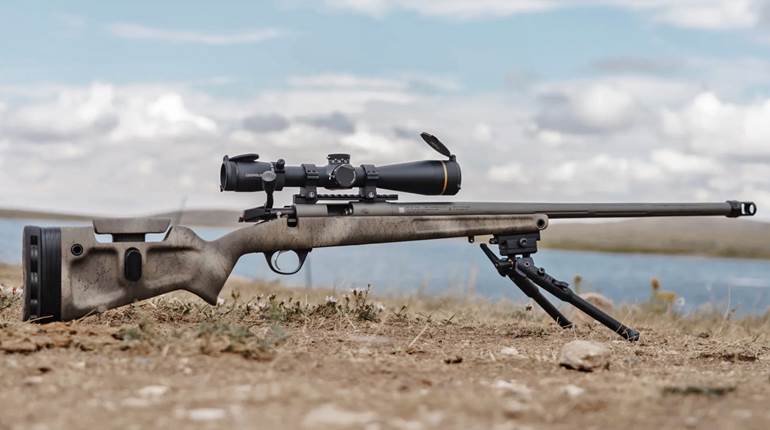
Building and selling guns in the United States is not an easy task. Considering the strict governmental regulations, pressure from the anti-gunners, and a plethora of frivolous lawsuits, we don't see too many new gunmakers cropping up these days. Not only is it refreshing to see a young gun company like FMK succeed in establishing its plant in the anti-gun state of California but it has chosen to provide its customers with 100 percent American-made pistols.
What's more, FMK is not afraid to let customers know just how it feels about this country. The 9C1 pistol could have been stamped with the words “Made in America.” Instead, the ejector is marked “Proudly American,” while the frame says “Thank You U.S. Soldiers.” The slide plate contains the words “Freedom and Liberty,” with the magazine base plate reading “E Pluribus Unum.” These are the markings of the plain-slide version of this pistol. FMK also offers the Bill of Rights version of the 9C1 with the first 10 amendments to the Constitution engraved on the slide.
Pistol Feature
The FMK 9C1 is a polymer-framed semi-auto chambered in 9 mm. The overall dimensions of the pistol are similar to a compact GLOCK or medium-frame Taurus. Guns in this size range offer a useful balance of shootability and ease of concealment for legal carry. The 9C1 weighs 23.45 ounces unloaded, accepts 14-round magazines and features an accessory rail for lights or lasers.
The matte-black, carbon-steel slide is beveled and shaped to give it an interesting profile when compared with the common square-block slides of other polymer-framed pistols. The slide is topped with a low profile three-dot sight system. Five additional rear sights and two more front sights are included in the case. These are easily traded out to allow shooters adjustments for sight height and windage.
Removing the slide from the frame reveals an interior arrangement that has taken various cues from GLOCK design. The blued steel barrel is 4 inches long, and the recoil assembly consists of a captured flat recoil spring supported by a polymer recoil rod. Like other pistols in this class, almost all of the 9C1 safeties are internal, such as the striker safety, which prevents a discharge if the gun is dropped. The single external safety is located in the trigger where it's released automatically as the trigger is pulled.
The 9C1 features two additional safeties not found on other striker guns. One is a magazine safety to prevent the pistol from firing if the magazine is removed. The other is a red plastic loaded chamber indicator located at the rear of the slide. It provides both a visible and tactile indication when the gun is loaded. Another feature not commonly found on semi-autos is a trigger that can be pulled to strike a cartridge primer a second time in case the round doesn't fire the first time. This is a useful way to avoid having to run a clearance drill if the cartridge in the chamber has a hard primer.
FMK has paid careful attention to the 9C1's ergonomics. Some pistols feature a dimple in the grip for the shooting-hand thumb to rest in. FMK has opted to extend the dimples into two channels running from the front to the back of the frame. The result is a noticeable narrowing of the grip for both the thumb and trigger finger. The trigger guard provides a more generous curve where it connects to the grip so as to give the middle finger more room.
The front of the grip has textured finger grooves. The sides of the grip are lightly textured and indented. These indentations do a terrific job of eliminating the blocky feel many polymer guns suffer from by providing a more intuitive resting place for the pads of the middle, ring and little finger. The indentation and texturing extend to the floor plate of the magazine.
The best of the many good features of the grip frame is the rubberized backstrap. This backstrap not only effectively reduces felt recoil, it hugs and grips the palm of the shooting hand to provide a comfortable, positive grip. The result is a grip that seems to mold to the shooter’s hand, instead of having to mold your hand to fit the grip. The 9C1 arrives with two magazines in a rugged, lockable, foam-lined hard case with a partitioned storage compartment for extra magazines or cleaning supplies.
At the Range
The 9C1's promise of comfortable shooting proved to be true. The compact grip frame provides enough room for a full three-finger grip. The shock-absorbing backstrap is effective at reducing felt recoil. This was especially true when using standard pressure rounds. It felt more like shooting a .380 than a 9 mm. For anyone looking for a low-recoil defensive option, the 9C1 would provide a good choice without reducing the caliber size.
The slide requires the usual amount of grip strength and pressure to cycle as most mid-sized 9 mm pistols. The magazine release has a smooth surface but it's easy to locate and operate. The blued-steel magazines are constructed in-house by FMK instead of a third-party vendor. They're sturdy, well constructed and all four of the test samples, including a 10-round version, locked tightly and dropped freely.
A digital trigger gauge shows the 9C1's long, smooth, Double-Action Only trigger weighing in at 7 pounds, 13 ounces. This places the trigger pull between the 10-pound-plus triggers of some pocket pistols and the 5-pounds-or-less pull of some safe-action and single-action pistols. Without any creep or stacking to get in the way of the stroke, the 9C1's trigger is easy to work.
Formal testing produced shot groups that were not as tight as I would like to see with the ammunition used, but sufficient for defensive applications. The best single five-shot group from 25 yards using a bench rest was 3.75 inches. This group, and the best five-group average of 4.65 inches, was produced using Hornady Critical Defense 115-grain FXT rounds. The next best group average of 5 inches was generated with Winchester 147-grain PDX1 jacketed hollow points, followed by an average of 5.2 inches from DoubleTap's 124-grain +P brass-jacketed hollow points.
Ammunition reliability and practical close-range accuracy of the 9C1 proved to be solid. At 7 yards, it was easy to cut a ragged 2-inch hole into the center of the target with a variety of practice and defense-grade ammunition using off-hand drills. The only malfunction in the course of testing was a single failure to feed. This occurred during the first 50 rounds fired using inexpensive bulk ammunition. After that, the pistol ran flawlessly.
Final Thoughts
The FMK 9C1 9 mm pistol is easy to carry, comfortable to shoot and reliable with a variety of ammunition. With an MSRP of $399, this pistol is hundreds of dollars less than other polymer, striker-fired pistols in its class. The 9C1 should be especially attractive to shooters looking for a concealed-carry gun, full-caliber low-recoil defensive option or an affordable pistol for home defense. Buying this pistol will keep your dollars right here, supporting a company that’s willing to stamp its patriotic devotion to this country into the guns it sells.
Manufacturer: FMK Firearms; fmkfirearms.com
Model: 9C1 Gen II
Action: Double-Action Only, Fast-Action Trigger Available
Caliber: 9 mm
Slide: High-Carbon Steel
Frame: Black, Pink, or Tan Polymer
Sights: Fixed three-Dot
Barrel Length: 4”
Overall Length: 6.85”
Height: 5.09”
Width: 1.14”
Weight:23.45 ozs.
Capacity: 14+1 Rounds
Twist: 1:16” LH
Rifle Grooves: 6
Accessories: 2 Magazines, 7 Interchangeable Sights, Lockable Case
Suggested Retail Price: $399












